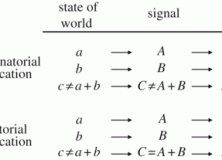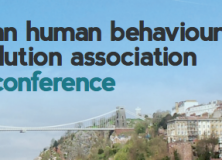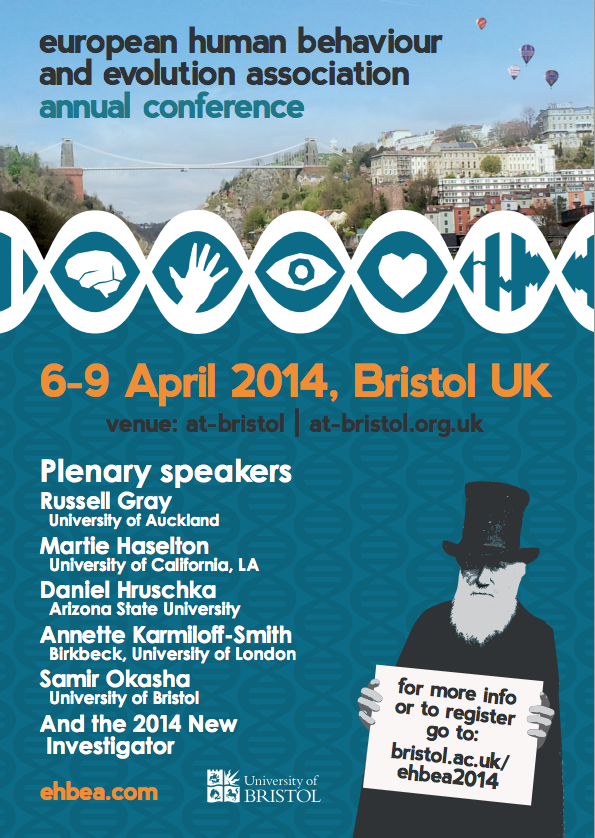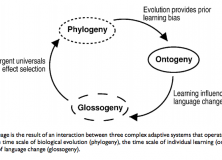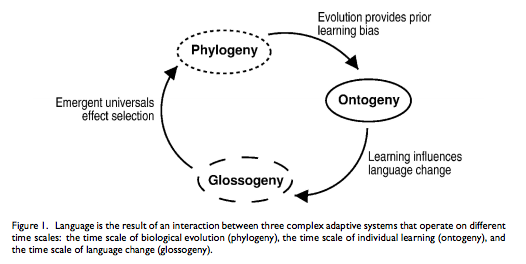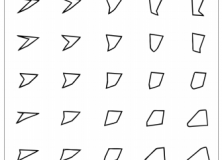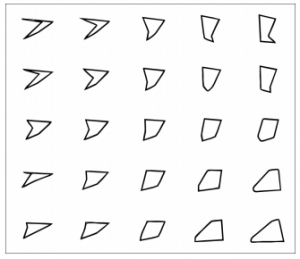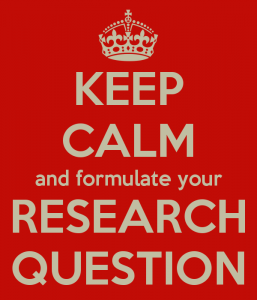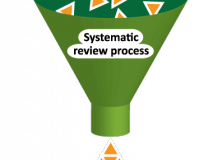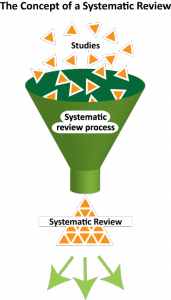Languages have structure on two levels. The level on which small meaningless building blocks (phonemes) make up bigger meaningful building blocks (morphemes), and the level of structure at which these meaningful building blocks make up even bigger meaningful structures (words, sentences, utterances). This was identified way back in the 1960s as one of Hockett’s design features for language know as “duality of patterning”, and in most of linguistics people refer to these different levels of structure as “phonology” and “(morpho)syntax”.
However, in recent years these contrasting levels of structure have started to be talked about in the context of language evolution, either in reference to artificial language learning experiments or experimental semiotics, where a proxy for language is used so it doesn’t make sense to talk about phonological or morphosyntactic structure, or when talking about animal communication where it also doesn’t make sense to talk about terms which pertain to human language. Instead, terms such as “combinatorial” and “compositional” structure are used, occasionally contrastively, or sometimes they get conflated to mean the same thing.
In the introduction to a recent special issue in Language and Cognition on new perspectives on duality of patterning, Bart de Boer, Wendy Sandler and Simon Kirby helpfully outline their preferred use of terminology:
Duality of patterning (Hockett, 1960) is the property of human language that enables combinatorial structure on two distinct levels: meaningless sounds can be combined into meaningful morphemes and words, which themselves could be combined further. We will refer to recombination at the first level as combinatorial structure, while recombination at the second level will be called compositional structure.
You will notice that they initially call both levels of structure “combinatorial”, and they both arguably are, and my point in this blog post isn’t necessarily that only structure on the first level should be called combinatorial, but that work talking about combinatorial structure should establish what their terminology means.
A recent paper by Scott-Philips and Blythe (2013), which is entitled “Why is combinatorial communication rare in the natural world, and why is language an exception to this trend?” presents an agent based model to show how limited the conditions are from which combinatorial communication can emerge. Obviously, in order to do this they need to define what they mean by combinatorial communication and present this figure by way of explanation:

They explain:
In a combinatorial communication system, two (or more) holistic signals (A and B in this figure) are combined to form a third, composite signal (A + B), which has a different effect (Z) to the sum of the two individual signals (X + Y). This figure illustrates the simplest combinatorial communication system possible. Applied to the putty-nosed monkey system, the symbols in this figure are: a, presence of eagles; b, presence of leopards; c, absence of food; A, ‘pyow’; B, ‘hack’ call; C = A + B ‘pyow–hack’; X, climb down; Y, climb up; Z ≠ X + Y, move to a new location. Combinatorial communication is rare in nature: many systems have a signal C = A + B with an effect Z = X + Y; very few have a signal C = A + B with an effect Z ≠ X + Y.
In this example, the building blocks which make C , A and B, are arguably meaningful because they act as signals in their own right, therefore, if C had a meaning which was a combination of the meanings of A and B, this system (using de Boer, Sandler and Kirby’s definition) would be compositional (this isn’t represented in the figure above). However, if the meaning of C is not a combination of the meanings of A and B, then A and B are arguably meaningless building blocks (and their individual expressions just happen to have meaning, for example the individual phoneme /a/ being an indefinite determiner in English, but not having this meaning when it is used in the word “cat”). In this case, the system would be combinatorial (as defined by the figure above, as well as under the definition of de Boer, Sadler and Kirby). So far so good, it looks like we are in agreement.
However, later in their paper Scott-Philips and Blythe go on to argue:
Coded ‘combinatorial’ signals are in a sense not really combinatorial at all. After all, there is no ‘combining’ going on. There is really just a third holistic signal, which happens to be comprised of the same pieces as other existing holistic signals. Indeed, the most recent experimental results suggest that the putty-nosed monkeys interpret the ‘combinatorial’ pyow–hack calls in exactly this idiomatic way, rather than as the product of two component parts of meaning. By contrast, the ostensive creation of new composite signals is clearly combinatorial: the meaning of the new, composite signal is in part (but only in part) a function of the meanings of the component pieces.
The argument they are giving here is that unless the meaning of C is a combination of A and B (or compositional as defined above), then it is not really a combinatorial signal.
Scott-Philips and Blythe definitely know and demonstrate that there is a difference between the two levels of structure, but they conflate them both under one term, “combinatorial”, which makes it harder to understand that there is a very clear difference. Also, changing the definition of what they mean by “combinatorial” between the introduction of their paper and their discussion confuses their argument.
Perhaps we should all agree to adopt the terminology proposed by de Boer, Sandler and Kirby, but given the absence of a consensus on the matter, at the very least I think outlining exactly what is meant by combinatorial (or compositional) needs to be established at the beginning of every paper using these terms.
References
de Boer, B., Sandler, W., & Kirby, S. (2012). New perspectives on duality of patterning: Introduction to the special issue. Language and Cognition, 4(4).
Hockett, C. 1960. The origin of speech. Scientific American 203. 88–111.
Scott-Phillips, T. C., & Blythe, R. A. (2013). Why is combinatorial communication rare in the natural world, and why is language an exception to this trend?. Journal of The Royal Society Interface, 10(88), 20130520.

